Medium-Resolution Mapping of Evapotranspiration at the Catchment Scale Based on Thermal Infrared MODIS Data and ERA-Interim Reanalysis over North Africa
Abstract
1. Introduction
2. Materials and Methods
2.1. Study Area
2.2. Fields Measurements
2.3. MODIS Data
2.4. ERA-Interim Dataset
2.5. Irrigation Water Amounts and Yields Statistics
2.6. The Two-Source Energy Balance Model
2.7. Extrapolation to Daily Value and Monthly Values
3. Results
3.1. Evaluation of ERA-Interim
3.2. Energy Budget Component from TSEB
3.2.1. Comparison to the Water Inputs + Precipitation
3.2.2. Comparison to Grain Yield
3.3. Spatial Variability of Evapotranspiration
3.3.1. Climatology
3.3.2. Interannual Variability of Evapotranspiration
3.3.3. Detection of New Irrigated Area
4. Discussion
5. Conclusions
- (a)
- Despite some differences, particularly a positive bias on the air temperature, the ERA-Interim meteorological data constitutes a true solution of forcing of the models compared to the stations of measurements for the areas where meteorological station networks are scarce.
- (b)
- TSEB, forced by a low-resolution remote sensing dataset, can reproduce four components of the energy budget reasonably well. Rn is correctly reproduced (r = 0.63 and RMSE = 73 W/m2), while the partition between sensible and latent heat seems very difficult to evaluate given the scale mismatch between the "satellite" predictions and the eddy correlation footprint. Nevertheless, the main trends of the latent heat fluxes seem to be properly reproduced, including the switch of energy occurring after harvest or the occurrence of a stress period.
- (c)
- For monthly water consumption of irrigated crops, the approach presents a strong overestimation (almost a factor of 2) compared to the water supply (equal to the irrigation water amounts provided by ORMVAH, the office in charge of the agricultural water in the region plus rainfall from an independent dataset). The first explanation is linked to the trend over the last few years of uncontrolled drilling that has affected the region. Farmers are supplementing ORMVAH water supplies with their own wells in order to secure the harvest, regardless of the crop's actual needs. A similar result was shown in Tunisia by Saadi et al. [3].
- (d)
- Daily mapping allows for anomaly analysis of intra- and interannual climate variability at the watershed scale. This allows understanding the distribution of cultivation practices.
- (e)
- This simple tool provides information, supported by yield data, to better understand the variability of grain production. This is information of the highest importance in the current climatic context and also provides a simple approach to detect new irrigated areas.
Author Contributions
Funding
Data Availability Statement
Acknowledgments
Conflicts of Interest
References
- Tramblay, Y.; Koutroulis, A.; Samaniego, L.; Vicente-Serrano, S.M.; Volaire, F.; Boone, A.; Le Page, M.; Llasat, M.C.; Albergel, C.; Burak, S.; et al. Challenges for Drought Assessment in the Mediterranean Region under Future Climate Scenarios. Earth-Sci. Rev. 2020, 210, 103348. [Google Scholar] [CrossRef]
- Pereira, L.S.; Oweis, T.; Zairi, A. Irrigation Management under Water Scarcity. Agric. Water Manag. 2002, 57, 175–206. [Google Scholar] [CrossRef]
- Saadi, S.; Simonneaux, V.; Boulet, G.; Raimbault, B.; Mougenot, B.; Fanise, P.; Ayari, H.; Lili-Chabaane, Z. Monitoring Irrigation Consumption Using High Resolution NDVI Image Time Series: Calibration and Validation in the Kairouan Plain (Tunisia). Remote Sens. 2015, 7, 13005–13028. [Google Scholar] [CrossRef]
- Fader, M.; Shi, S.; Von Bloh, W.; Bondeau, A.; Cramer, W. Mediterranean Irrigation under Climate Change: More Efficient Irrigation Needed to Compensate for Increases in Irrigation Water Requirements. Hydrol. Earth Syst. Sci. 2016, 20, 953–973. [Google Scholar] [CrossRef]
- Jarlan, L.; Khabba, S.; Szczypta, C.; Lili-Chabaane, Z.; Driouech, F.; Le Page, M.; Hanich, L.; Fakir, Y.; Boone, A.; Boulet, G. Water Resources in South Mediterranean Catchments Assessing Climatic Drivers and Impacts. Mediterr. Reg. Clim. Chang. 2016, 2010, 303–309. [Google Scholar]
- Kuper, M.; Ameur, F.; Hammani, A. Unraveling the Enduring Paradox of Increased Pressure on Groundwater through Efficient Drip Irrigation. In Drip Irrigation Agriculture; Routledge: London, UK, 2018; pp. 85–104. [Google Scholar] [CrossRef]
- Liu, S.; Han, Y.; Su, H. Regional Evapotranspiration Estimation by the Improved MOD16-Sm Model and Its Application in Central China. Water 2022, 14, 1491. [Google Scholar] [CrossRef]
- Milly, P.C. Climate, Soil Water Storage, and the Average Annual Water Balance. Water Resour. Res. 1994, 30, 2143–2156. [Google Scholar] [CrossRef]
- Allen, R.G.; Pereira, L.S.; Howell, T.A.; Jensen, M.E. Evapotranspiration Information Reporting: I. Factors Governing Measurement Accuracy. Agric. Water Manag. 2011, 98, 899–920. [Google Scholar] [CrossRef]
- Allen, R.G.; Pereira, L.S.; Raes, D.; Smith, M. Crop Evapotranspiration (Guidelines for Computing Crop Water Requirements). Agronomy 1998, 300, D05109. [Google Scholar] [CrossRef]
- Jasechko, S.; Sharp, Z.D.; Gibson, J.J.; Birks, S.J.; Yi, Y.; Fawcett, P.J. Terrestrial Water Fluxes Dominated by Transpiration. Nature 2013, 496, 347–350. [Google Scholar] [CrossRef]
- Aouade, G.; Jarlan, L.; Ezzahar, J.; Er-Raki, S.; Napoly, A.; Benkaddour, A.; Khabba, S.; Boulet, G.; Garrigues, S.; Chehbouni, A.; et al. Evapotranspiration Partition Using the Multiple Energy Balance Version of the ISBA-A-Gs Land Surface Model over Two Irrigated Crops in a Semi-Arid Mediterranean Region (Marrakech, Morocco). Hydrol. Earth Syst. Sci. 2020, 24, 3789–3814. [Google Scholar] [CrossRef]
- Boulet, G.; Jarlan, L.; Olioso, A.; Nieto, H. Evapotranspiration in the Mediterranean Region; Elsevier Inc.: Amsterdam, The Netherlands, 2020; ISBN 9780128180860. [Google Scholar]
- Twine, T.E.; Kustas, W.P.; Norman, J.M.; Cook, D.R.; Houser, P.R.; Meyers, T.P.; Prueger, J.H.; Starks, P.J.; Wesely, M.L. Correcting Eddy-Covariance Flux Underestimates over a Grassland. Agric. For. Meteorol. 2000, 103, 279–300. [Google Scholar] [CrossRef]
- Ezzahar, J.; Chehbouni, A.; Hoedjes, J.C.B.; Chehbouni, A. On the Application of Scintillometry over Heterogeneous Grids. J. Hydrol. 2007, 334, 493–501. [Google Scholar] [CrossRef]
- Zhang, K.; Kimball, J.S.; Running, S.W. A Review of Remote Sensing Based Actual Evapotranspiration Estimation. Wiley Interdiscip. Rev. Water 2016, 3, 834–853. [Google Scholar] [CrossRef]
- Courault, D.; Seguin, B.; Olioso, A. Review on Estimation of Evapotranspiration from Remote Sensing Data: From Empirical to Numerical Modeling Approaches. Irrig. Drain. Syst. 2005, 19, 223–249. [Google Scholar] [CrossRef]
- Diarra, A.; Jarlan, L.; Er-Raki, S.; Le Page, M.; Aouade, G.; Tavernier, A.; Boulet, G.; Ezzahar, J.; Merlin, O.; Khabba, S. Performance of the Two-Source Energy Budget (TSEB) Model for the Monitoring of Evapotranspiration over Irrigated Annual Crops in North Africa. Agric. Water Manag. 2017, 193, 71–88. [Google Scholar] [CrossRef]
- Bigeard, G.; Coudert, B.; Chirouze, J.; Er-Raki, S.; Boulet, G.; Ceschia, E.; Jarlan, L. Ability of a Soil-Vegetation-Atmosphere Transfer Model and a Two-Source Energy Balance Model to Predict Evapotranspiration for Several Crops and Climate Conditions. Hydrol. Earth Syst. Sci. 2019, 23, 5033–5058. [Google Scholar] [CrossRef]
- Er-Raki, S.; Chehbouni, A.; Hoedjes, J.; Ezzahar, J.; Duchemin, B.; Jacob, F. Improvement of FAO-56 Method for Olive Orchards through Sequential Assimilation of Thermal Infrared-Based Estimates of ET. Agric. Water Manag. 2008, 95, 309–321. [Google Scholar] [CrossRef]
- Albergel, C.; Calvet, J.C.; Mahfouf, J.F.; Rüdiger, C.; Barbu, A.L.; Lafont, S.; Roujean, J.L.; Walker, J.P.; Crapeau, M.; Wigneron, J.P. Monitoring of Water and Carbon Fluxes Using a Land Data Assimilation System: A Case Study for Southwestern France. Hydrol. Earth Syst. Sci. 2010, 14, 1109–1124. [Google Scholar] [CrossRef]
- Albergel, C.; Dutra, E.; Munier, S.; Calvet, J.C.; Munoz-Sabater, J.; De Rosnay, P.; Balsamo, G. ERA-5 and ERA-Interim Driven ISBA Land Surface Model Simulations: Which One Performs Better? Hydrol. Earth Syst. Sci. 2018, 22, 3515–3532. [Google Scholar] [CrossRef]
- Anderson, M.C.; Kustas, W.P.; Norman, J.M.; Hain, C.R.; Mecikalski, J.R.; Schultz, L.; González-Dugo, M.P.; Cammalleri, C.; D’Urso, G.; Pimstein, A.; et al. Mapping Daily Evapotranspiration at Field to Continental Scales Using Geostationary and Polar Orbiting Satellite Imagery. Hydrol. Earth Syst. Sci. 2011, 15, 223–239. [Google Scholar] [CrossRef]
- Massari, C.; Modanesi, S.; Dari, J.; Gruber, A.; De Lannoy, G.J.M.; Girotto, M.; Quintana-Seguí, P.; Le Page, M.; Jarlan, L.; Zribi, M.; et al. A Review of Irrigation Information Retrievals from Space and Their Utility for Users. Remote Sens. 2021, 13, 4112. [Google Scholar] [CrossRef]
- Le Page, M.; Jarlan, L.; El Hajj, M.M.; Zribi, M.; Baghdadi, N.; Boone, A. Potential for the Detection of Irrigation Events on Maize Plots Using Sentinel-1 Soil Moisture Products. Remote Sens. 2020, 12, 1621. [Google Scholar] [CrossRef]
- Ouaadi, N.; Jarlan, L.; Khabba, S.; Ezzahar, J.; Le Page, M.; Merlin, O. Irrigation Amounts and Timing Retrieval through Data Assimilation of Surface Soil Moisture into the Fao-56 Approach in the South Mediterranean Region. Remote Sens. 2021, 13, 2667. [Google Scholar] [CrossRef]
- Moran, M.S.; Clarke, T.R.; Inoue, Y.; Vidal, A. Estimating Crop Water Deficit Using the Relation between Surface-Air Temperature and Spectral Vegetation Index. Remote Sens. Environ. 1994, 49, 246–263. [Google Scholar] [CrossRef]
- Kalma, J.D.; McVicar, T.R.; McCabe, M.F. Estimating Land Surface Evaporation: A Review of Methods Using Remotely Sensed Surface Temperature Data. Surv. Geophys. 2008, 29, 421–469. [Google Scholar] [CrossRef]
- Brenner, C.; Zeeman, M.; Bernhardt, M.; Schulz, K. Estimation of Evapotranspiration of Temperate Grassland Based on High-Resolution Thermal and Visible Range Imagery from Unmanned Aerial Systems. Int. J. Remote Sens. 2018, 39, 5141–5174. [Google Scholar] [CrossRef] [PubMed]
- Zhang, C.; Long, D.; Zhang, Y.; Anderson, M.C.; Kustas, W.P.; Yang, Y. A Decadal (2008–2017) Daily Evapotranspiration Data Set of 1 Km Spatial Resolution and Spatial Completeness across the North China Plain Using TSEB and Data Fusion. Remote Sens. Environ. 2021, 262. [Google Scholar] [CrossRef]
- Guzinski, R.; Nieto, H.; Sandholt, I.; Karamitilios, G. Modelling High-Resolution Actual Evapotranspiration through Sentinel-2 and Sentinel-3 Data Fusion. Remote Sens. 2020, 12, 1433. [Google Scholar] [CrossRef]
- Merlin, O.; Duchemin, B.; Hagolle, O.; Jacob, F.; Coudert, B.; Chehbouni, G.; Dedieu, G.; Garatuza, J.; Kerr, Y. Disaggregation of MODIS Surface Temperature over an Agricultural Area Using a Time Series of Formosat-2 Images. Remote Sens. Environ. 2010, 114, 2500–2512. [Google Scholar] [CrossRef]
- Anderson, M.C.; Norman, J.M.; Diak, G.R.; Kustas, W.P.; Mecikalski, J.R.; Anderson, M.C. A Two-Source Time-Integrated Model for Estimating Surface Fluxes Using Thermal Infrared Remote Sensing; Elsevier Science Inc.: Amsterdam, The Netherlands, 1997; Volume 60. [Google Scholar]
- Su, Z. Application of Simplified Surface Energy Balance Index (S-SEBI) for Crop Evapotranspiration Using Landsat 8. Hydrol. Earth Syst. Sci. 2002, 61, 85–99. [Google Scholar] [CrossRef]
- Norman, J.M.; Kustas, W.P.; Humes, K.S. Source Approach for Estimating Soil and Vegetation Energy Fluxes in Observations of Directional Radiometric Surface Temperature. Agric. For. Meteorol. 1995, 77, 263–293. [Google Scholar] [CrossRef]
- Chirouze, J.; Boulet, G.; Jarlan, L.; Fieuzal, R.; Rodriguez, J.C.; Ezzahar, J.; Er-Raki, S.; Bigeard, G.; Merlin, O.; Garatuza, J.; et al. Inter-Comparison of Four Remote Sensing Based Surface Energy Balance Methods Hydrology and Earth System Sciences Discussions. Hydrol. Earth Syst. Sci. Discuss 2013, 10, 895–963. [Google Scholar] [CrossRef]
- Kustas, W.P.; Norman, J.M. Reply to Comments about the Basic Equations of Dual-Source Vegetation-Atmosphere Transfer Models. Agric. For. Meteorol. 1999, 94, 275–278. [Google Scholar] [CrossRef]
- Boulet, G.; Mougenot, B.; Lhomme, J.P.; Fanise, P.; Lili-Chabaane, Z.; Olioso, A.; Bahir, M.; Rivalland, V.; Jarlan, L.; Merlin, O.; et al. The SPARSE Model for the Prediction of Water Stress and Evapotranspiration Components from Thermal Infra-Red Data and Its Evaluation over Irrigated and Rainfed Wheat. Hydrol. Earth Syst. Sci. 2015, 19, 4653–4672. [Google Scholar] [CrossRef]
- Amazirh, A.; Er-Raki, S.; Chehbouni, A.; Rivalland, V.; Diarra, A.; Khabba, S.; Ezzahar, J.; Merlin, O. Modified Penman–Monteith Equation for Monitoring Evapotranspiration of Wheat Crop: Relationship between the Surface Resistance and Remotely Sensed Stress Index. Biosyst. Eng. 2017, 164, 68–84. [Google Scholar] [CrossRef]
- Bastiaanssen, W.G.M.; Menenti, M.; Feddes, R.A.; Holtslag, A.A.M. A Remote Sensing Surface Energy Balance Algorithm for Land (SEBAL) 1. Formulation. J. Hydrol. 1998, 212–213, 198–212. [Google Scholar] [CrossRef]
- Mecikalski, J.R.; Diak, G.R.; Anderson, M.C.; Norman, J.M. Estimating Fluxes on Continental Scales Using Remotely Sensed Data in an Atmospheric-Land Exchange Model. J. Appl. Meteorol. 1999, 38, 1352–1369. [Google Scholar] [CrossRef]
- Kustas, W.P.; Norman, J.M. A Two-Source Energy Balance Approach Using Directional Radiometric Temperature Observations for Sparse Canopy Covered Surfaces. Agron. J. 2000, 92, 847–854. [Google Scholar] [CrossRef]
- Allen, R.G.; Tasumi, M.; Morse, A.; Trezza, R.; Wright, J.L.; Bastiaanssen, W.; Kramber, W.; Lorite, I.; Robison, C.W. Satellite-Based Energy Balance for Mapping Evapotranspiration with Internalized Calibration (METRIC)—Applications. J. Irrig. Drain. Eng. 2007, 133, 395–406. [Google Scholar] [CrossRef]
- Yang, Y.; Su, H.; Zhang, R.; Tian, J.; Li, L. An Enhanced Two-Source Evapotranspiration Model for Land (ETEML): Algorithm and Evaluation. Remote Sens. Environ. 2015, 168, 54–65. [Google Scholar] [CrossRef]
- Choi, M.; Kustas, W.P.; Anderson, M.C.; Allen, R.G.; Li, F.; Kjaersgaard, J.H. An Intercomparison of Three Remote Sensing-Based Surface Energy Balance Algorithms over a Corn and Soybean Production Region (Iowa, U.S.) during SMACEX. Agric. For. Meteorol. 2009, 149, 2082–2097. [Google Scholar] [CrossRef]
- Timmermans, W.J.; Kustas, W.P.; Anderson, M.C.; French, A.N. An Intercomparison of the Surface Energy Balance Algorithm for Land (SEBAL) and the Two-Source Energy Balance (TSEB) Modeling Schemes. Remote Sens. Environ. 2007, 108, 369–384. [Google Scholar] [CrossRef]
- Elfarkh, J.; Ezzahar, J.; Er-Raki, S.; Simonneaux, V.; Hssaine, B.A.; Rachidi, S.; Brut, A.; Rivalland, V.; Khabba, S.; Chehbouni, A.; et al. Multi-Scale Evaluation of the TSEB Model over a Complex Agricultural Landscape in Morocco. Remote Sens. 2020, 12, 1181. [Google Scholar] [CrossRef]
- Hssaine, B.A.; Merlin, O.; Rafi, Z.; Ezzahar, J.; Jarlan, L.; Khabba, S.; Er-Raki, S. Calibrating an Evapotranspiration Model Using Radiometric Surface Temperature, Vegetation Cover Fraction and near-Surface Soil Moisture Data. Agric. For. Meteorol. 2018, 256–257, 104–115. [Google Scholar] [CrossRef]
- Dee, D.P.; Uppala, S.M.; Simmons, A.J.; Berrisford, P.; Poli, P.; Kobayashi, S.; Andrae, U.; Balmaseda, M.A.; Balsamo, G.; Bauer, P.; et al. The ERA-Interim Reanalysis: Configuration and Performance of the Data Assimilation System. Q. J. R. Meteorol. Soc. 2011, 137, 553–597. [Google Scholar] [CrossRef]
- Jones, P.D.; Harpham, C.; Troccoli, A.; Gschwind, B.; Ranchin, T.; Wald, L.; Goodess, C.M.; Dorling, S. Using ERA-Interim Reanalysis for Creating Datasets of Energy-Relevant Climate Variables. Earth Syst. Sci. Data 2017, 9, 471–495. [Google Scholar] [CrossRef]
- Simmons, A.J.; Poli, P.; Dee, D.P.; Berrisford, P.; Hersbach, H.; Kobayashi, S.; Peubey, C. Estimating Low-Frequency Variability and Trends in Atmospheric Temperature Using ERA-Interim. Q. J. R. Meteorol. Soc. 2014, 140, 329–353. [Google Scholar] [CrossRef]
- Szczypta, C. Hydrologie Spatiale Pour Le Suivi Des Sécheresses Du Bassin Méditerranéen. Ph.D. Thesis, Institut National Polytechnique de Toulouse (INPT), Toulouse, France, 2012; pp. 1–197. [Google Scholar]
- Compo, G.P.; Whitaker, J.S.; Sardeshmukh, P.D.; Matsui, N.; Allan, R.J.; Yin, X.; Gleason, B.E.; Vose, R.S.; Rutledge, G.; Bessemoulin, P.; et al. The Twentieth Century Reanalysis Project. Q. J. R. Meteorol. Soc. 2011, 137, 1–28. [Google Scholar] [CrossRef]
- Chehbouni, A.; Escadafal, R.; Duchemin, B.; Boulet, G.; Simonneaux, V.; Dedieu, G.; Mougenot, B.; Khabba, S.; Kharrou, H.; Maisongrande, P.; et al. An Integrated Modelling and Remote Sensing Approach for Hydrological Study in Arid and Semi-Arid Regions: The SUDMED Programme. Int. J. Remote Sens. 2008, 29, 5161–5181. [Google Scholar] [CrossRef]
- Jarlan, L.; Khabba, S.; Er-Raki, S.; Le Page, M.; Hanich, L.; Fakir, Y.; Merlin, O.; Mangiarotti, S.; Gascoin, S.; Ezzahar, J.; et al. Remote Sensing of Water Resources in Semi-Arid Mediterranean Areas: The Joint International Laboratory TREMA. Int. J. Remote Sens. 2015, 36, 4879–4917. [Google Scholar] [CrossRef]
- Duchemin, B.; Hadria, R.; Erraki, S.; Boulet, G.; Maisongrande, P.; Chehbouni, A.; Escadafal, R.; Ezzahar, J.; Hoedjes, J.C.B.; Kharrou, M.H.; et al. Monitoring Wheat Phenology and Irrigation in Central Morocco: On the Use of Relationships between Evapotranspiration, Crops Coefficients, Leaf Area Index and Remotely-Sensed Vegetation Indices. Agric. Water Manag. 2006, 79, 1–27. [Google Scholar] [CrossRef]
- Duchemin, B.; Hagolle, O.; Mougenot, B.; Benhadj, I.; Hadria, R.; Simonneaux, V.; Ezzahar, J.; Hoedjes, J.; Khabba, S.; Kharrou, M.H.; et al. Agrometerological Study of Semi-Ard Areas: An Experiment for Analysing the Potential of Time Series of FORMOSAT-2 Images (Tensift-Marrakech Plain). Int. J. Remote Sens. 2008, 29, 5291–5299. [Google Scholar] [CrossRef]
- Benhadj, I.; Duchemin, B.; Maisongrande, P.; Simonneaux, V.; Khabba, S.; Chehbouni, A. Automatic Unmixing of MODIS Multi-Temporal Data for Inter-Annual Monitoring of Land Use at a Regional Scale (Tensift, Morocco). Int. J. Remote Sens. 2012, 33, 1325–1348. [Google Scholar] [CrossRef]
- Balaghi, R.; Tychon, B.; Eerens, H.; Jlibene, M. Empirical Regression Models Using NDVI, Rainfall and Temperature Data for the Early Prediction of Wheat Grain Yields in Morocco. Int. J. Appl. Earth Obs. Geoinf. 2008, 10, 438–452. [Google Scholar] [CrossRef]
- Bouras, E.H.; Jarlan, L.; Er-Raki, S.; Balaghi, R.; Amazirh, A.; Richard, B.; Khabba, S. Cereal Yield Forecasting with Satellite Drought-Based Indices, Weather Data and Regional Climate Indices Using Machine Learning in Morocco. Remote Sens. 2021, 13, 3101. [Google Scholar] [CrossRef]
- Jarlan, L.; Abaoui, J.; Duchemin, B.; Ouldbba, A.; Tourre, Y.M.; Khabba, S.; Le Page, M.; Balaghi, R.; Mokssit, A.; Chehbouni, G. Linkages between Common Wheat Yields and Climate in Morocco (1982-2008). Int. J. Biometeorol. 2014, 58, 1489–1502. [Google Scholar] [CrossRef]
- Er-Raki, S.; Chehbouni, A.; Guemouria, N.; Duchemin, B.; Ezzahar, J.; Hadria, R. Combining FAO-56 Model and Ground-Based Remote Sensing to Estimate Water Consumptions of Wheat Crops in a Semi-Arid Region. Agric. Water Manag. 2007, 87, 41–54. [Google Scholar] [CrossRef]
- Toumi, J.; Er-Raki, S.; Ezzahar, J.; Khabba, S.; Jarlan, L.; Chehbouni, A. Performance Assessment of AquaCrop Model for Estimating Evapotranspiration, Soil Water Content and Grain Yield of Winter Wheat in Tensift Al Haouz (Morocco): Application to Irrigation Management. Agric. Water Manag. 2016, 163, 219–235. [Google Scholar] [CrossRef]
- Khabba, S.; Er-raki, S.; Toumi, J.; Ezzahar, J.; Hssaine, B.A.; Le Page, M.; Chehbouni, A. Agronomy A Simple Light-Use-E Ffi Ciency Model to Estimate Wheat Yield in the Semi-Arid Areas. Agronomy 2020, 10, 1524. [Google Scholar] [CrossRef]
- Wang, P.; Song, X.; Han, D.; Zhang, Y.; Zhang, B. Determination of Evaporation, Transpiration and Deep Percolation of Summer Corn and Winter Wheat after Irrigation. Agric. Water Manag. 2012, 105, 32–37. [Google Scholar] [CrossRef]
- Duchemin, B.; Er-Raki, S.; Gentine, P.; Maisongrande, P.; Coret, L.; Boulet, G.; Rodriguez, J.C.; Simonneaux, V.; Chehbouni, A.; Dedieu, G.; et al. Estimating Cereal Evapotranspiration Using a Simple Model Driven by Satellite Data. Int. Geosci. Remote Sens. Symp. 2003, 4, 2762–2764. [Google Scholar] [CrossRef]
- Ezzahar, J.; Chehbouni, A.; Hoedjes, J.C.B.; Er-Raki, S.; Chehbouni, A.; Boulet, G.; Bonnefond, J.M.; De Bruin, H.A.R. The Use of the Scintillation Technique for Monitoring Seasonal Water Consumption of Olive Orchards in a Semi-Arid Region. Agric. Water Manag. 2007, 89, 173–184. [Google Scholar] [CrossRef]
- Simonneaux, V.; Duchemin, B.; Helson, D.; Er-Raki, S.; Olioso, A.; Chehbouni, A.G. The Use of High-Resolution Image Time Series for Crop Classification and Evapotranspiration Estimate over an Irrigated Area in Central Morocco. Int. J. Remote Sens. 2008, 29, 95–116. [Google Scholar] [CrossRef]
- Gutman, G.; Ignatov, A. The Derivation of the Green Vegetation Fraction from NOAA/AVHRR Data for Use in Numerical Weather Prediction Models. Int. J. Remote Sens. 1998, 19, 1533–1543. [Google Scholar] [CrossRef]
- Zeng, X.; Dickinson, R.E.; Walker, A.; Shaikh, M.; Defries, R.S.; Qi, J. Derivation and Evaluation of Global 1-Km Fractional Vegetation Cover Data for Land Modeling. J. Appl. Meteorol. 2000, 39, 826–839. [Google Scholar] [CrossRef]
- Beck, H.E.; Wood, E.F.; Pan, M.; Fisher, C.K.; Miralles, D.G.; Van Dijk, A.I.J.M.; McVicar, T.R.; Adler, R.F. MSWep v2 Global 3-Hourly 0.1° Precipitation: Methodology and Quantitative Assessment. Bull. Am. Meteorol. Soc. 2019, 100, 473–500. [Google Scholar] [CrossRef]
- Gao, P.; Xu, X.; Zhang, X. On the Relationship between the QBO/ENSO and Atmospheric Temperature Using COSMIC Radio Occultation Data. J. Atmos. Solar-Terr. Phys. 2017, 156, 103–110. [Google Scholar] [CrossRef]
- Brutsaert, W. Evaporation into the Atmosphere; Springer: Berlin/Heidelberg, Germany, 1982; ISBN 9789401714976. [Google Scholar]
- Harris, I.; Jones, P.D.; Osborn, T.J.; Lister, D.H. Updated High-Resolution Grids of Monthly Climatic Observations–The CRU TS3.10 Dataset. Int. J. Climatol. 2014, 34, 623–642. [Google Scholar] [CrossRef]
- Nogueira, M. Inter-Comparison of ERA-5, ERA-Interim and GPCP Rainfall over the Last 40 Years: Process-Based Analysis of Systematic and Random Differences. J. Hydrol. 2020, 583, 124632. [Google Scholar] [CrossRef]
- Bouras, E.H.; Jarlan, L.; Er-Raki, S.; Albergel, C.; Richard, B.; Balaghi, R.; Khabba, S. Linkages between Rainfed Cereal Production and Agricultural Drought through Remote Sensing Indices and a Land Data Assimilation System: A Case Study in Morocco. Remote Sens. 2020, 12, 4018. [Google Scholar] [CrossRef]
- Kustas, W.P.; Norman, J.M. Evaluation of Soil and Vegetation Heat Flux Predictions Using a Simple Two-Source Model with Radiometric Temperatures for Partial Canopy Cover. Agric. For. Meteorol. 1999, 94, 13–29. [Google Scholar] [CrossRef]
- Kustas, W.P.; Alfieri, J.G.; Anderson, M.C.; Colaizzi, P.D.; Prueger, J.H.; Evett, S.R.; Neale, C.M.U.; French, A.N.; Hipps, L.E.; Chávez, J.L.; et al. Evaluating the Two-Source Energy Balance Model Using Local Thermal and Surface Flux Observations in a Strongly Advective Irrigated Agricultural Area. Adv. Water Resour. 2012, 50, 120–133. [Google Scholar] [CrossRef]
- Brutsaert, W.H.; Reidel, D. Evaporation into the Atmosphere: Theory, History, and Applications. Q. J. R. Meteorol. Soc. 1983, 109, 267. [Google Scholar] [CrossRef]
- Choudhury, B.J.; Monteith, J.L. A Four-Layer Model for the Heat Budget of Homogeneous Land Surfaces; Royal Meteorological Society: Oxford, UK, 1988; Volume 114. [Google Scholar]
- Priestley, C.H.B.; Taylor, R.J.; Physics, R.J.T.A. On the Assessment of Surface Heat Flux and Evaporation Using Large-Scale Parameters. Mon. Weather Rev. 1972, 100, 81–92. [Google Scholar] [CrossRef]
- French, A.N. Scaling of Surface Energy Fluxes Unsing Remotely Sensed Data. Ph D. Thesis, University of Maryland, College Park, MD, USA, 2001. [Google Scholar]
- Delogu, E.; Boulet, G.; Olioso, A.; Coudert, B.; Chirouze, J.; Ceschia, E.; Le Dantec, V.; Marloie, O.; Chehbouni, G.; Lagouarde, J.P. Reconstruction of Temporal Variations of Evapotranspiration Using Instantaneous Estimates at the Time of Satellite Overpass. Hydrol. Earth Syst. Sci. 2012, 16, 2995–3010. [Google Scholar] [CrossRef]
- Ryu, Y.; Baldocchi, D.D.; Black, T.A.; Detto, M.; Law, B.E.; Leuning, R.; Miyata, A.; Reichstein, M.; Vargas, R.; Ammann, C.; et al. On the Temporal Upscaling of Evapotranspiration from Instantaneous Remote Sensing Measurements to 8-Day Mean Daily-Sums. Agric. For. Meteorol. 2012, 152, 212–222. [Google Scholar] [CrossRef]
- Liu, R.; Wen, J.; Wang, X.; Wang, Z. Validation of Evapotranspiration and Its Long-Term Trends in the Yellow River Source Region. J. Water Clim. Chang. 2017, 8, 495–509. [Google Scholar] [CrossRef][Green Version]
- Srivastava, P.K.; Han, D.; Islam, T.; Petropoulos, G.P.; Gupta, M.; Dai, Q. Seasonal Evaluation of Evapotranspiration Fluxes from MODIS Satellite and Mesoscale Model Downscaled Global Reanalysis Datasets. Theor. Appl. Climatol. 2016, 124, 461–473. [Google Scholar] [CrossRef]
- Szczypta, C.; Calvet, J.C.; Albergel, C.; Balsamo, G.; Boussetta, S.; Carrer, D.; Lafont, S.; Meurey, C. Verification of the New ECMWF ERA-Interim Reanalysis over France. Hydrol. Earth Syst. Sci. 2011, 15, 647–666. [Google Scholar] [CrossRef]
- Simmons, A.J.; Willett, K.M.; Jones, P.D.; Thorne, P.W.; Dee, D.P. Low-Frequency Variations in Surface Atmospheric Humidity, Temperature, and Precipitation: Inferences from Reanalyses and Monthly Gridded Observational Data Sets. J. Geophys. Res. Atmos. 2010, 115, 1–21. [Google Scholar] [CrossRef]
- Brohan, P.; Kennedy, J.J.; Harris, I.; Tett, S.F.B.; Jones, P.D. Uncertainty Estimates in Regional and Global Observed Temperature Changes: A New Data Set from 1850. J. Geophys. Res. Atmos. 2006, 111. [Google Scholar] [CrossRef]
- Guzinski, R.; Nieto, H.; Jensen, R.; Mendiguren, G. Remotely Sensed Land-Surface Energy Fluxes at Sub-Field Scale in Heterogeneous Agricultural Landscape and Coniferous Plantation. Biogeosciences 2014, 11, 5021–5046. [Google Scholar] [CrossRef]
- Anderson, M.C.; Cammalleri, C.; Hain, C.R.; Otkin, J.; Zhan, X.; Kustas, W. Using a Diagnostic Soil-Plant-Atmosphere Model for Monitoring Drought at Field to Continental Scales. Procedia Environ. Sci. 2013, 19, 47–56. [Google Scholar] [CrossRef][Green Version]
- Ezzahar, J.; Chehbouni, A.; Er-Raki, S.; Hanich, L. Combining a Large Aperture Scintillometer and Estimates of Available Energy to Derive Evapotranspiration over Several Agricultural Fields in a Semi-Arid Region. Plant Biosyst. 2009, 143, 209–221. [Google Scholar] [CrossRef]
- Chirouze, J.; Boulet, G.; Jarlan, L.; Fieuzal, R.; Rodriguez, J.C.; Ezzahar, J.; Er-Raki, S.; Bigeard, G.; Merlin, O.; Garatuza-Payan, J.; et al. Intercomparison of Four Remote-Sensing-Based Energy Balance Methods to Retrieve Surface Evapotranspiration and Water Stress of Irrigated Fields in Semi-Arid Climate. Hydrol. Earth Syst. Sci. 2014, 18, 1165–1188. [Google Scholar] [CrossRef]
- Castelli, M.; Anderson, M.C.; Yang, Y.; Wohlfahrt, G.; Bertoldi, G.; Niedrist, G.; Hammerle, A.; Zhao, P.; Zebisch, M.; Notarnicola, C. Two-Source Energy Balance Modeling of Evapotranspiration in Alpine Grasslands. Remote Sens. Environ. 2018, 209, 327–342. [Google Scholar] [CrossRef]
- Gómez-Candón, D.; Bellvert, J.; Royo, C. Performance of the Two-Source Energy Balance (TSEB) Model as a Tool for Monitoring the Response of Durum Wheat to Drought by High-Throughput Field Phenotyping. Front. Plant Sci. 2021, 12, 658357. [Google Scholar] [CrossRef]
- Nassah, H.; Er-Raki, S.; Khabba, S.; Fakir, Y.; Raibi, F.; Merlin, O.; Mougenot, B. Evaluation and Analysis of Deep Percolation Losses of Drip Irrigated Citrus Crops under Non-Saline and Saline Conditions in a Semi-Arid Area. Biosyst. Eng. 2018, 165, 10–24. [Google Scholar] [CrossRef]
- Semmens, K.A.; Anderson, M.C.; Kustas, W.P.; Gao, F.; Alfieri, J.G.; McKee, L.; Prueger, J.H.; Hain, C.R.; Cammalleri, C.; Yang, Y.; et al. Monitoring Daily Evapotranspiration over Two California Vineyards Using Landsat 8 in a Multi-Sensor Data Fusion Approach. Remote Sens. Environ. 2016, 185, 155–170. [Google Scholar] [CrossRef]
- Abtew, W.; Melesse, A. Evaporation and Evapotranspiration: Measurements and Estimations. Evaporation Evapotranspiration Measurements and Estimation; Springer: Berlin/Heidelberg, Germany, 2013; Volume 11, pp. 61–175. [Google Scholar] [CrossRef]
- Melesse, A.M.; Nangia, V. Estimation of Spatially Distributed Surface Energy Fluxes Using Remotely-Sensed Data for Agricultural Fields. Hydrol. Process. 2005, 19, 2653–2670. [Google Scholar] [CrossRef]
- Steduto, P.; Hsiao, T.C.; Raes, D.; Fereres, E. Aquacrop-the FAO Crop Model to Simulate Yield Response to Water: I. Concepts and Underlying Principles. Agron. J. 2009, 101, 426–437. [Google Scholar] [CrossRef]
- Kharrou, M.H.; Er-Raki, S.; Chehbouni, A.; Duchemin, B.; Simonneaux, V.; LePage, M.; Ouzine, L.; Jarlan, L. Water Use Efficiency and Yield of Winter Wheat under Different Irrigation Regimes in a Semi-Arid Region. Agric. Sci. 2011, 02, 273–282. [Google Scholar] [CrossRef]
- Ouassanouan, Y.; Fakir, Y.; Simonneaux, V.; Kharrou, M.H.; Bouimouass, H.; Najar, I.; Benrhanem, M.; Sguir, F.; Chehbouni, A. Multi-Decadal Analysis of Water Resources and Agricultural Change in a Mediterranean Semiarid Irrigated Piedmont under Water Scarcity and Human Interaction. Sci. Total Environ. 2022, 834, 155328. [Google Scholar] [CrossRef] [PubMed]
- Kharrou, H. Apport de La Teledetection Spatiale a l’analyse de La Performance Des Systemes d’irrigation En Zones Semi-Arides. Ph.D. Thesis, Cadi Ayyad Univesity, Marrakech, Morocco, 2014. [Google Scholar]
- Elwan, E.; Le Page, M.; Jarlan, L.; Baghdadi, N.; Brocca, L.; Modanesi, S.; Dari, J.; Segui, P.Q.; Zribi, M. Irrigation Mapping on Two Contrasted Climatic Contexts Using Sentinel-1 and Sentinel-2 Data. Water 2022, 14, 804. [Google Scholar] [CrossRef]
- Portmann, F.T.; Siebert, S.; Döll, P. MIRCA2000-Global Monthly Irrigated and Rainfed Crop Areas around the Year 2000: A New High-Resolution Data Set for Agricultural and Hydrological Modeling. Global Biogeochem. Cycles 2010, 24, GB1011. [Google Scholar] [CrossRef]
- Siebert, S.; Döll, P. Quantifying Blue and Green Virtual Water Contents in Global Crop Production as Well as Potential Production Losses without Irrigation. J. Hydrol. 2010, 384, 198–217. [Google Scholar] [CrossRef]
- Abbasi, N.; Nouri, H.; Didan, K.; Barreto-Muñoz, A.; Borujeni, S.C.; Salemi, H.; Opp, C.; Siebert, S.; Nagler, P. Estimating Actual Evapotranspiration over Croplands Using Vegetation Index Methods and Dynamic Harvested Area. Remote Sens. 2021, 13, 5167. [Google Scholar] [CrossRef]
- Bai, J.; Chen, X.; Li, L.; Luo, G.; Yu, Q. Quantifying the Contributions of Agricultural Oasis Expansion, Management Practices and Climate Change to Net Primary Production and Evapotranspiration in Croplands in Arid Northwest China. J. Arid Environ. 2014, 100–101, 31–41. [Google Scholar] [CrossRef]
- Hersbach, H.; Bell, B.; Berrisford, P.; Hirahara, S.; Horányi, A.; Muñoz-Sabater, J.; Nicolas, J.; Peubey, C.; Radu, R.; Schepers, D.; et al. The ERA5 Global Reanalysis. Q. J. R. Meteorol. Soc. 2020, 146, 1999–2049. [Google Scholar] [CrossRef]
- Muñoz-sabater, J.; Dutra, E.; Agustí-panareda, A.; Albergel, C.; Hersbach, H.; Martens, B.; Miralles, D.G.; Piles, M.; Rodríguez-fernández, N.J. ERA5-Land : A State-of-the-Art Global Reanalysis Dataset for Land Applications. Earth Syst. Sci. Data. 2021, 13, 4349–4383. [Google Scholar] [CrossRef]
- Baigorria, G.A.; Hansen, J.W.; Ward, N.; Jones, J.W.; O’Brien, J.J. Assessing Predictability of Cotton Yields in the Southeastern United States Based on Regional Atmospheric Circulation and Surface Temperatures. J. Appl. Meteorol. Climatol. 2008, 47, 76–91. [Google Scholar] [CrossRef]
- Brisson, N.; Mary, B.; Ripoche, D.; Jeuffroy, M.H.; Ruget, F.; Nicoullaud, B.; Gate, P.; Devienne-Barret, F.; Antonioletti, R.; Durr, C.; et al. STICS: A Generic Model for the Simulation of Crops and Their Water and Nitrogen Balances. I. Theory and Parameterization Applied to Wheat and Corn. Agronomie 1998, 18, 311–346. [Google Scholar] [CrossRef]
- Hansen, J.W.; Jones, J.W.; Irmak, A.; Royce, F. El Niño-Southern Oscillation Impacts on Crop Production in the Southeast United States. In Impacts of El Niño and Climate Variability on Agriculture; Frontiers Media: Lausanne, Switzerland, 2001. [Google Scholar] [CrossRef]
- Hansen, J.W.; Challinor, A.; Ines, A.; Wheeler, T.; Moron, V. Translating Climate Forecasts into Agricultural Terms: Advances and Challenges. Clim. Res. 2006, 33, 27–41. [Google Scholar] [CrossRef]
- Le Page, M.; Zribi, M. Analysis and Predictability of Drought In Northwest Africa Using Optical and Microwave Satellite Remote Sensing Products. Sci. Rep. 2019, 9, 1466. [Google Scholar] [CrossRef] [PubMed]
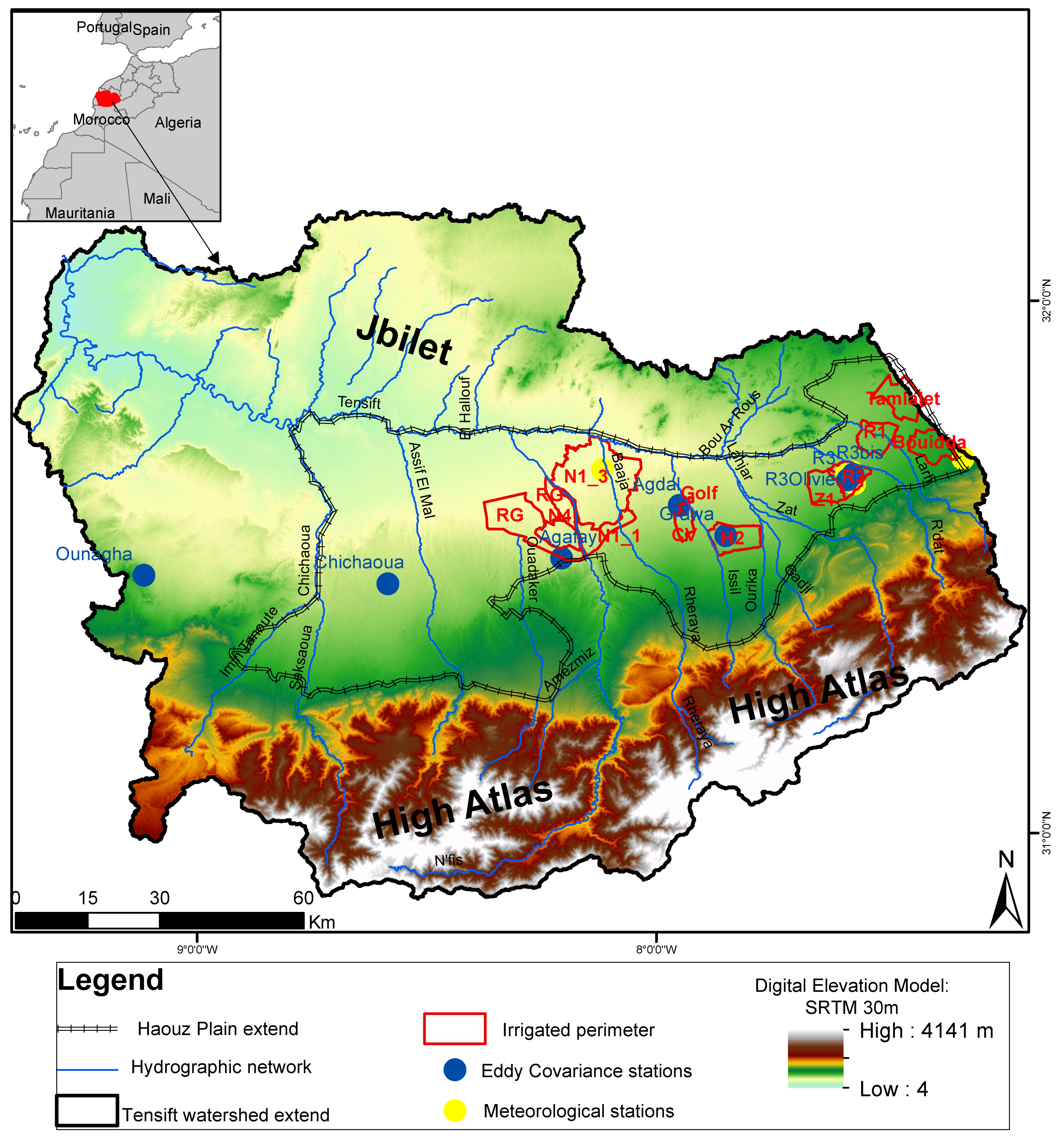
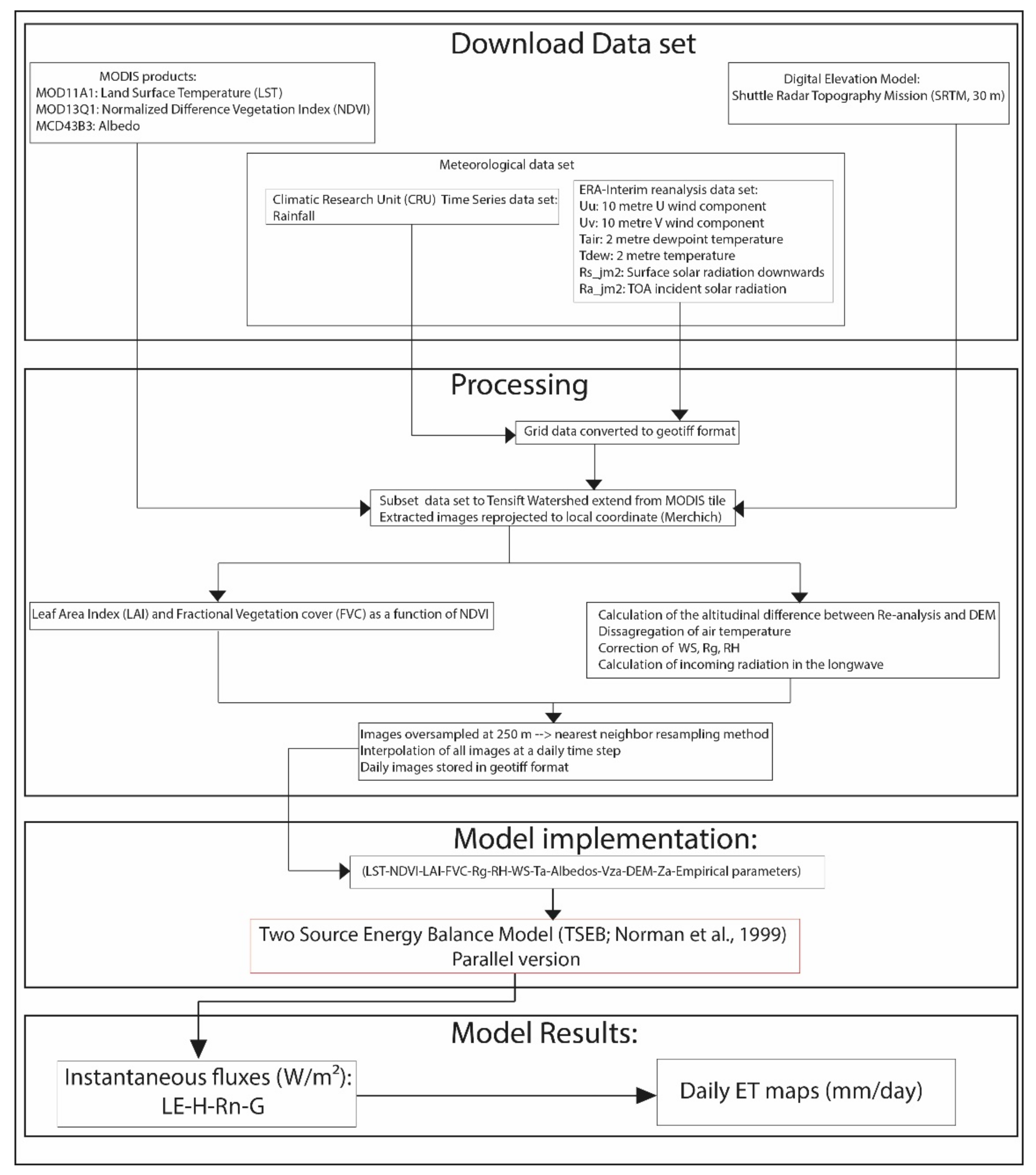
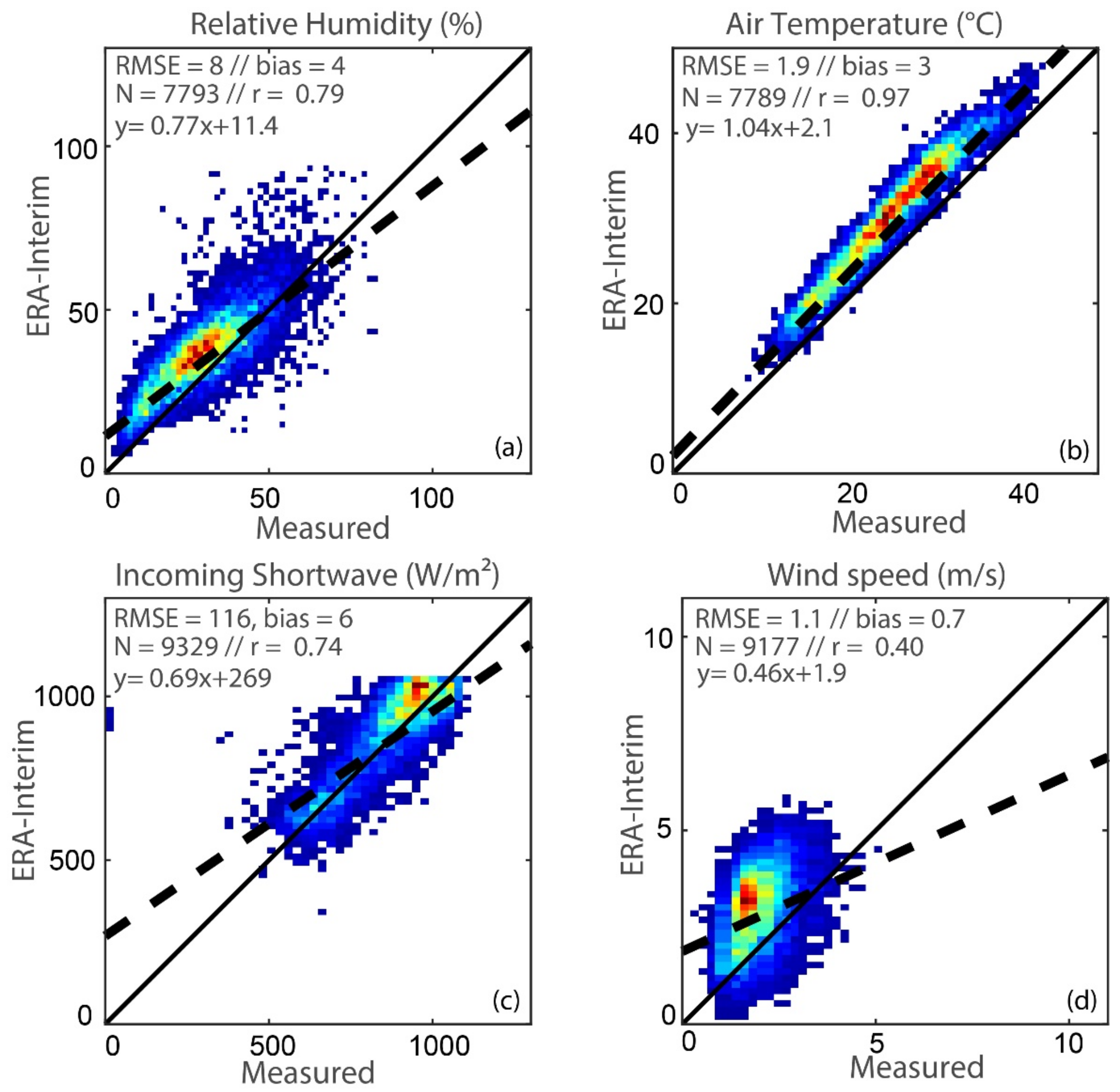
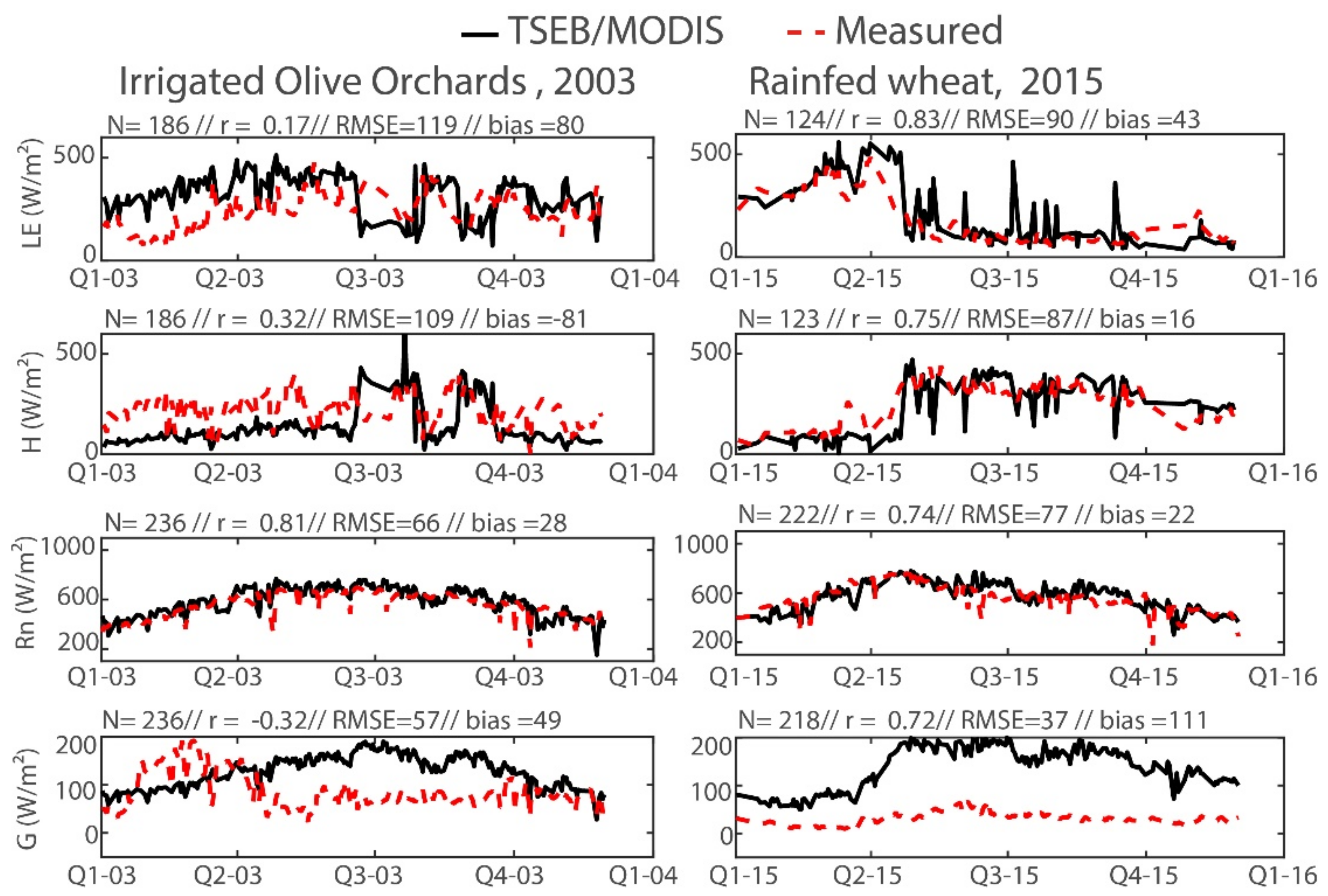

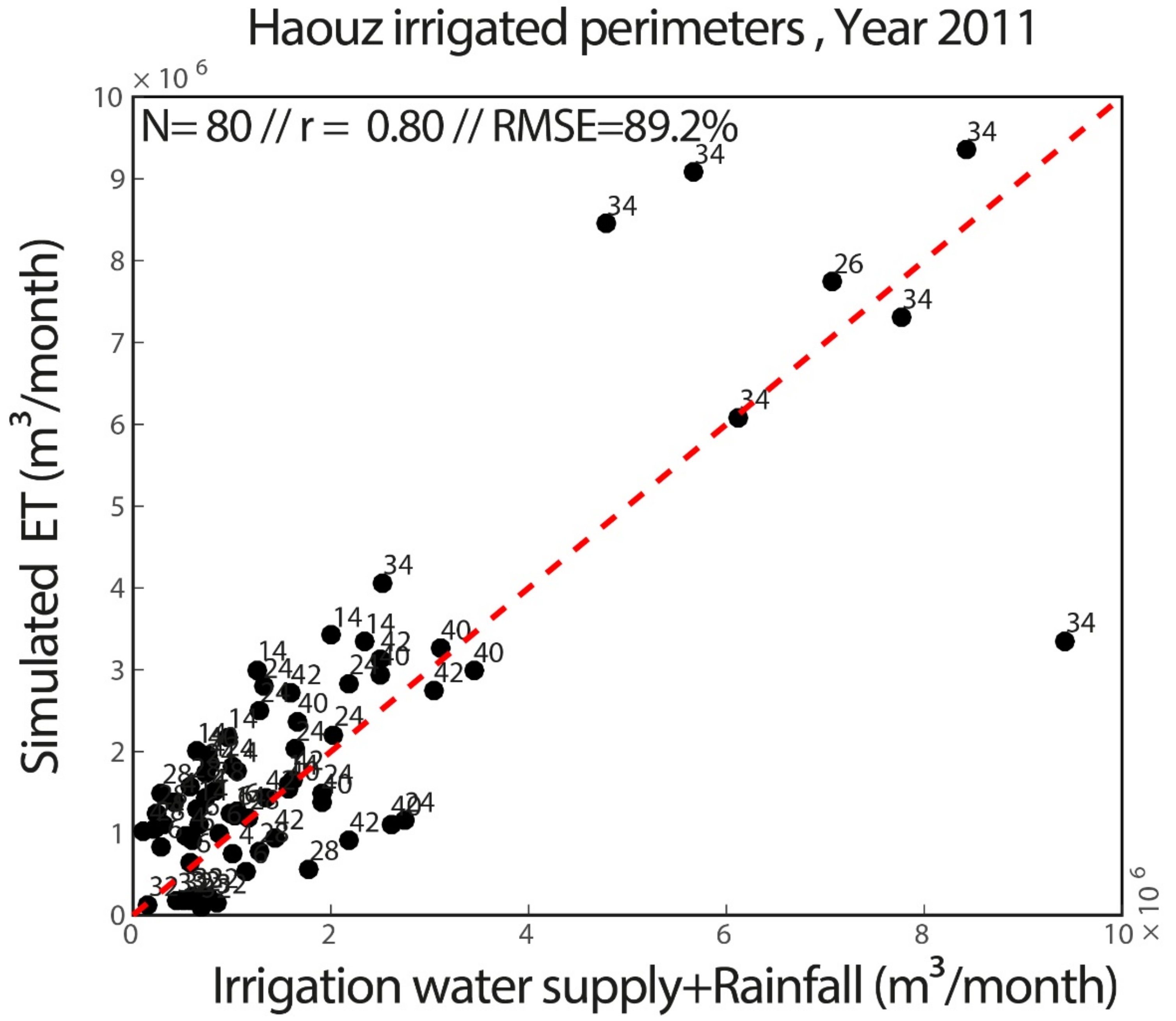

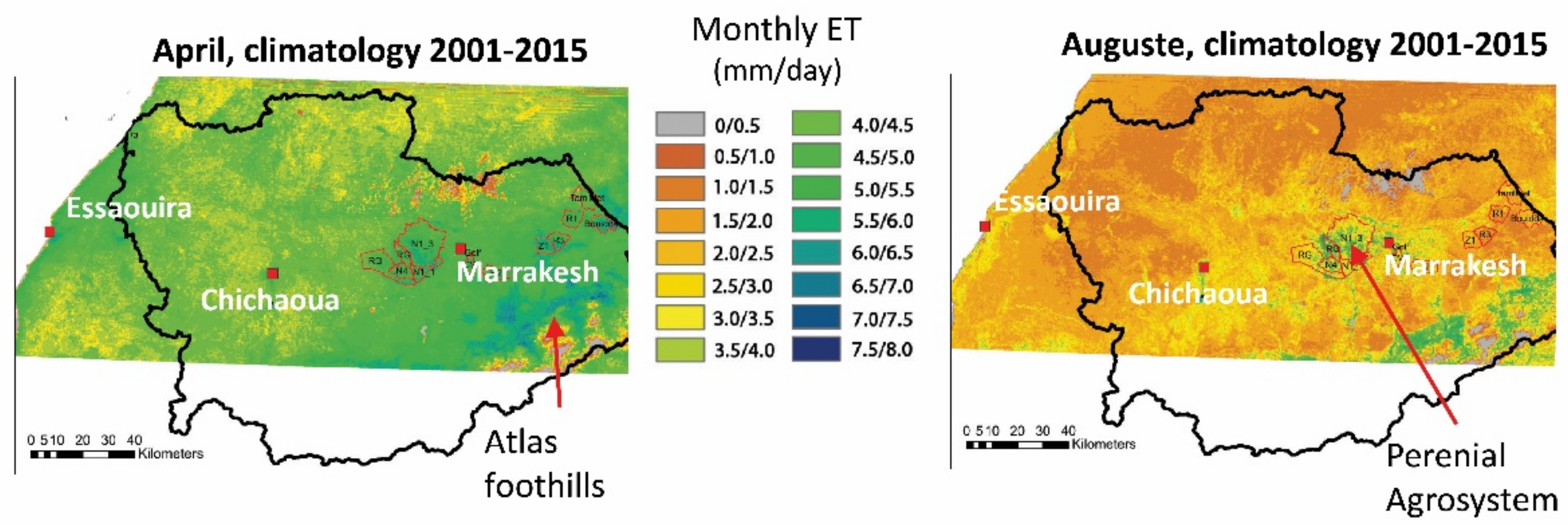

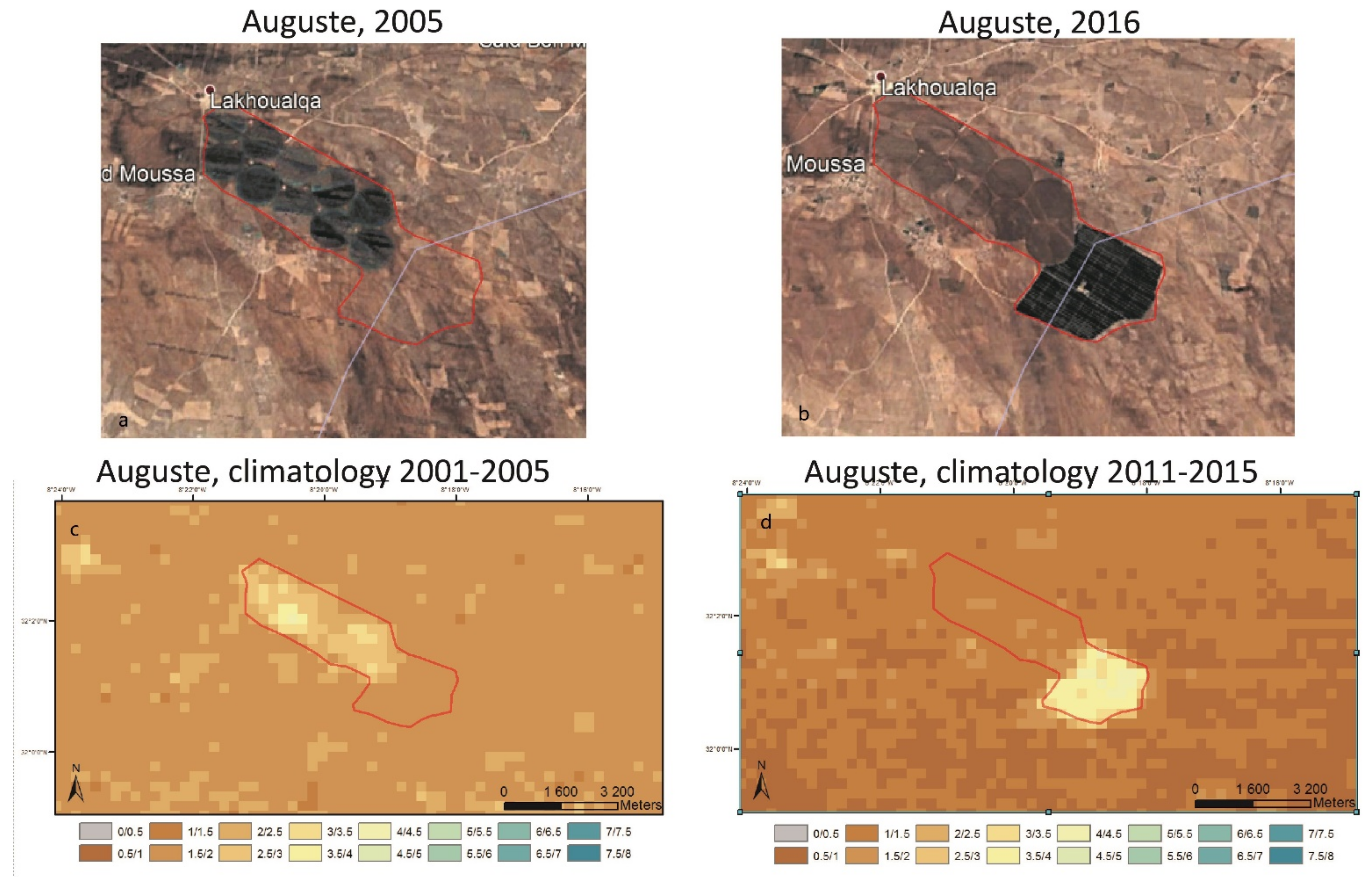
| Site ID | Lon | Lat | Alt | Equipment * | Variable * | Crops | Period |
|---|---|---|---|---|---|---|---|
| Eddy Covariance Stations | |||||||
| Agafay | –8.2281 | 31.4964 | 506 | Hygrometer Krypton (KH2O) Three-dimensional sonic anemometer (CSAT) Vaisala (HMP45C) | Latent heat flux LE (W/m2) Sensible heat flux H (W/m2) | Irrigated citrus | 2006–2009 |
| Agdal | –7.9739 | 31.6014 | 479 | Olive orchard | 2003–2004 | ||
| R3_2003 | –7.5953 | 31.6669 | 593 | Irrigated wheat | 2003 | ||
| R3_2004 | –7.5959 | 31.6725 | 593 | Irrigated wheat | 2004 | ||
| R3_2012 | –7.6071 | 31.6728 | 591 | Net radiometer (CNR1) | Net radiation Rn (W/m2) | Irrigated wheat | 2012 |
| R3 Olive tree | –7.6320 | 31.6618 | 590 | Olive orchard | 2005–2006 | ||
| R3_2013 | –7.5891 | 31.6494 | 593 | Irrigated wheat | 2013 | ||
| Sidi Rahal_2014 | –7.5891 | 31.6494 | 580 | Flux plates (HPF01) | Soil conduction G (W/m2) | Rainfed wheat | 2014 |
| Sidi Rahal_2015 | –7.3523 | 31.7009 | 564 | Rainfed wheat | 2015 | ||
| Saada | –7.6071 | 31.6728 | 415 | Irrigated citrus | 2004–2005 | ||
| Meteorological Stations | |||||||
| Agdal | –7.9738 | 31.6012 | 506 | Pyranometer (CM3) | Incident radiation Rg (W/m2) | Olive orchard | 2004 |
| Agafay | –8.2280 | 31.4964 | 479 | Vaisala (HMP45C) Anemometer (A100R) | Wind speed WS (m/s) Relative humidity RH (%) Air temperature Ta (°C) | Grass Tall | 2003 |
| Chichaoua | –8.6078 | 31.4392 | 517 | Rainfed wheat | 2012 | ||
| Grawa | –7.8700 | 31.5469 | 523 | Irrigated wheat | 2006 | ||
| Ounagha | –9.2826 | 31.4430 | 430 | Alfafa | 2008 | ||
| R3 | –7.6050 | 31.6570 | 593 | Rain gauge (FSS500) | Rain P (mm/day) | Irrigated wheat | 2003 |
| R3 Olive tree | –7.5933 | 31.6675 | 593 | Olive orchard | 2015 | ||
| R3bis | –7.5933 | 31.6675 | 593 | Alfafa | 2004–2005 | ||
| Variables | N | r | RMSE | bias |
|---|---|---|---|---|
| Air temperature (°C) | 7789 | 0.97 | 1.9 | 3.0 |
| Relative humidity (%) | 7793 | 0.79 | 8.0 | 4.0 |
| Radiation incident (W/m2) | 9329 | 0.74 | 116 | 6.0 |
| Wind speed (m/s) | 9177 | 0.40 | 1.1 | 0.7 |
| CV | R1 | R3 | Z1 | H2 | RG | RD | N1 | Total | |
|---|---|---|---|---|---|---|---|---|---|
| Index | 4 | 40 | 42 | 14 | 26 | 34 | 32 | 28 | - |
| r | 0.54 | 0.52 | 0.63 | 0.73 | 0.19 | 0.48 | 0.31 | 0.40 | 0.8 |
| RMSE (%) | 115 | 41 | 43 | 88 | 55 | 37 | 65 | 61 | 89 |
| bias (%) | 65 | 55 | 67 | 74 | 118 | 45 | 58 | 52 | 60 |
Publisher’s Note: MDPI stays neutral with regard to jurisdictional claims in published maps and institutional affiliations. |
© 2022 by the authors. Licensee MDPI, Basel, Switzerland. This article is an open access article distributed under the terms and conditions of the Creative Commons Attribution (CC BY) license (https://creativecommons.org/licenses/by/4.0/).
Share and Cite
Diarra, A.; Jarlan, L.; Khabba, S.; Le Page, M.; Er-Raki, S.; Balaghi, R.; Charafi, S.; Chehbouni, A.; El Alami, R. Medium-Resolution Mapping of Evapotranspiration at the Catchment Scale Based on Thermal Infrared MODIS Data and ERA-Interim Reanalysis over North Africa. Remote Sens. 2022, 14, 5071. https://doi.org/10.3390/rs14205071
Diarra A, Jarlan L, Khabba S, Le Page M, Er-Raki S, Balaghi R, Charafi S, Chehbouni A, El Alami R. Medium-Resolution Mapping of Evapotranspiration at the Catchment Scale Based on Thermal Infrared MODIS Data and ERA-Interim Reanalysis over North Africa. Remote Sensing. 2022; 14(20):5071. https://doi.org/10.3390/rs14205071
Chicago/Turabian StyleDiarra, Alhousseine, Lionel Jarlan, Saïd Khabba, Michel Le Page, Salah Er-Raki, Riad Balaghi, Soufyane Charafi, Abdelghani Chehbouni, and Rafiq El Alami. 2022. "Medium-Resolution Mapping of Evapotranspiration at the Catchment Scale Based on Thermal Infrared MODIS Data and ERA-Interim Reanalysis over North Africa" Remote Sensing 14, no. 20: 5071. https://doi.org/10.3390/rs14205071
APA StyleDiarra, A., Jarlan, L., Khabba, S., Le Page, M., Er-Raki, S., Balaghi, R., Charafi, S., Chehbouni, A., & El Alami, R. (2022). Medium-Resolution Mapping of Evapotranspiration at the Catchment Scale Based on Thermal Infrared MODIS Data and ERA-Interim Reanalysis over North Africa. Remote Sensing, 14(20), 5071. https://doi.org/10.3390/rs14205071








